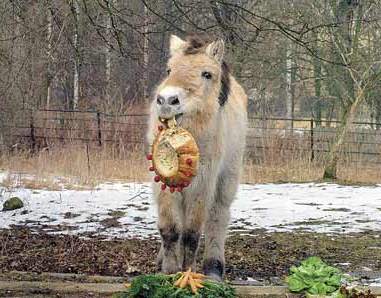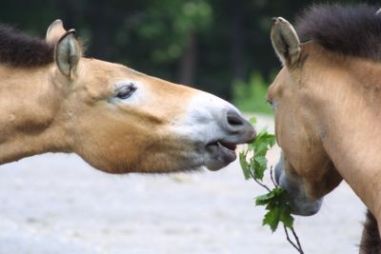
August 14, 2006

Cilka (above) was a beauty.
The world’s oldest known Przewalski horse died on August 12, 2006. The mare named Cilka was 34, and she died peacefully at the Prague zoo. Her ancestors lived in the grasslands of central Asia. Indeed, this animal’s legacy was as a member of a group that survived from the Ice Ages, and her hairy appearance showed her links to the Pleistocene.
As wire service news of her death mentioned:
Only about two dozen of the world’s estimated 2,000 Przewalski horses are over age 30….The Przewalski horse, or Takh, a national symbol in Mongolia, is the only surviving subspecies of horse that has never been domesticated. The horses once inhabited grasslands of central Asia, but became extinct in the wild in the 1960s….Some 300 of the horses now live in the wild.


More photographs of Cilka, without and with her winter coat.
The Przewalski’s horse, a living fossil, is of interest to cryptozoologists.
The species (Equus ferus przewalskii, Equus caballus przewalskii, or Equus przewalski poliakov – classification is debated) is the last truly wild horse, discovered in Mongolia in 1881. The horse’s discoverer, Nikolai Mikhailovich Przhevalsky (1839–1888), also spelled Przewalski and Prjevalsky, was a Russian geographer and explorer in central and eastern Asia. He conducted five major expeditions – one to the Ussuri area in the Russian Far East (1867–68) and four to Mongolia, Xinjiang, and Tibet (1870–85).
Early in the fifteenth century, Hans Schiltenberger was captured by the Turks and sent to the court of Tamerlane. After returning to Europe in 1427, Schiltenberger wrote about his experiences. In his book, he described some mountains, apparently the Tien Shan range in Mongolia and said he saw hairy Wildmen there. (Today we call them Almas.)
Schiltenberger also referred to horses that would later be called Przewalski horses, which were only rediscovered by Nicholai Przewalski in 1881. Przewalski himself saw Almas (Wildmen) in Mongolia in 1871.
About Loren Coleman
Loren Coleman is one of the world’s leading cryptozoologists, some say “the” leading living cryptozoologist. Certainly, he is acknowledged as the current living American researcher and writer who has most popularized cryptozoology in the late 20th and early 21st centuries.
Starting his fieldwork and investigations in 1960, after traveling and trekking extensively in pursuit of cryptozoological mysteries, Coleman began writing to share his experiences in 1969. An honorary member of Ivan T. Sanderson’s Society for the Investigation of the Unexplained in the 1970s, Coleman has been bestowed with similar honorary memberships of the North Idaho College Cryptozoology Club in 1983, and in subsequent years, that of the British Columbia Scientific Cryptozoology Club, CryptoSafari International, and other international organizations. He was also a Life Member and Benefactor of the International Society of Cryptozoology (now-defunct).
Loren Coleman’s daily blog, as a member of the Cryptomundo Team, served as an ongoing avenue of communication for the ever-growing body of cryptozoo news from 2005 through 2013. He returned as an infrequent contributor beginning Halloween week of 2015.
Coleman is the founder in 2003, and current director of the International Cryptozoology Museum in Portland, Maine.
Filed under Almas, Breaking News, CryptoZoo News, Cryptozoology, Expedition Reports, Eyewitness Accounts, Obituaries